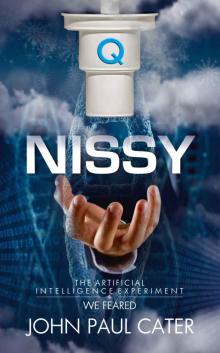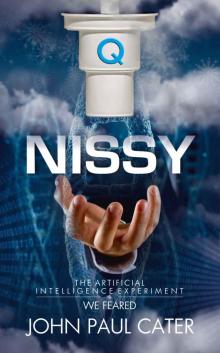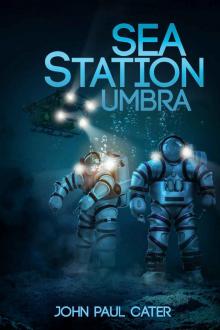- Home
- JOHN PAUL CATER
NISSY
NISSY Read online
NISSY
The Artificial
Intelligence Experiment
We Feared
JOHN PAUL CATER
BY JOHN PAUL CATER
Fiction
THE ENDLIGHT EVENT
ENDLIGHT DAWNING 2012
SATELLITE LOST
PI DAY DOOMSDAY
SEA STATION UMBRA
NEAR-EARTH OBJECT 2017AP
NISSY
Nonfiction
ELECTRONICALLY SPEAKING: COMPUTER SPEECH GENERATION
ELECTRONICALLY HEARING: COMPUTER SPEECH RECOGNITION
All rights reserved.
Copyright © 2018 by John P. Cater
Cover design and production by
Panagiotis Lampridis
No part of this book may be reproduced or transmitted in any form or by any means, electronic, or mechanical, including recording, photocopying or by any information retrieval or storage system, without permission in writing from the author.
NISSY
Paperback
ISBN-13: 978-1978196131
ISBN-10: 197819613X
This is a work of fiction. Names, characters, businesses, places, events and incidents are either the products of the author’s imagination or used in a fictitious manner.
Any resemblance to actual persons, living or dead, or actual events is purely coincidental.
In loving memory of my Jaye…
November 1, 1955 – June 13, 2017
CONTENTS
INTRODUCTION
PART ONE - IN THE BEGINNING
Chapter 1
Chapter 2
Chapter 3
Chapter 4
Chapter 5
Chapter 6
Chapter 7
PART TWO - A NEW LIFE
Chapter 8
Chapter 9
Chapter 10
Chapter 11
Chapter 12
Chapter 13
PART THREE - NISSY VN.1
Chapter 14
Chapter 15
Chapter 16
Chapter 17
PART FOUR – MONSTER
Chapter 18
Chapter 19
Chapter 20
PART FIVE – 2027
Chapter 21
Chapter 22
Chapter 23
Chapter 24
Chapter 25
Chapter 26
Chapter 27
Chapter 28
APPENDIX
DNA FASTA FILE TRANSLATION TABLE
About the Author
“A year spent in artificial intelligence is enough to make one believe in God.”
-Alan Perlis
“The development of full artificial intelligence could spell the end of the human race….It would take off on its own, and re-design itself at an ever increasing rate. Humans, who are limited by slow biological evolution, couldn't compete, and would be superseded.”
-Stephen Hawking
“The pace of progress in artificial intelligence (I’m not referring to narrow AI) is incredibly fast. Unless you have direct exposure to groups like DeepMind, you have no idea how fast—it is growing at a pace close to exponential. The risk of something seriously dangerous happening is in the five-year timeframe, 10 years at most.”
-Elon Musk
“I don’t want to really scare you, but it was alarming how many people I talked to who are highly placed people in AI who have retreats that are sort of 'bug out' houses, to which they could flee if it all hits the fan.”
-James Barrat
INTRODUCTION
T his is a fictional story set in the near future about the inevitable meeting of two scientific visionaries, herein portrayed as Jason Godwin and Blake Lipinski, delving independently into the controversial emerging sciences of artificial intelligence and the creation of synthetic life. The primary differences between these real-life ventures are their goals.
I say real-life ventures because this research is ongoing now, in secret labs behind closed doors. And if you’ll read the news you’ll see mention of these new facets of science. But because they’re so advanced in scope employing almost unfathomable technologies, and the public is becoming resistant to news of revolutionary scientific achievements, they go unnoticed for the most part.
Clarifying the facets involves examination of the terminologies.
Artificial intelligence (AI) is the creation of human (sentient) or higher intelligence using a complex computer-based system to model the brain (a brilliant mind without a body).
Synthetic life, alternatively, is steeped in microscopic biological synthesis much akin to constructing Mary Shelley’s Frankenstein using only genome and DNA sequencing (piecing together the four DNA CGAT nucleotides, cytosine, guanine, adenine, and thymine into the helix of life). A living entity absent a mind so to speak. And while the two fields are currently mutually exclusive, one not influencing the other, they will not always remain that way.
Both fields of research presented in this book exist today, as mentioned above, but with some educated extrapolations in their design and functionality. As for the science of AI, IBM’s Watson and Deep Blue are two successful systems that are experts in preselected fields while Google’s DeepMind is more general in its knowledge, learning everything in its grasp. Legendary leaders in the industry who have guided these efforts in one way or another include Alan Turing, Marvin Minsky, Edward Feigenbaum, Doug Lenat, and of course the crew at IBM.
Quantum computing on the other hand is still in its infancy so there are only few groundbreakers, notably D-Wave Systems, Inc. forging the way.
Finally and possibly foremost, an almost implausible technology has only recently slipped through the scientific web, reminiscent of a sci-fi plot with its incredulity. Its father is J. Craig Venter, CEO and founder of J. Craig Venter Institute and (SGI) Synthetic Genomics, Inc. creator of Synthia in 2010. This singularity in artificial life is a rapidly self-replicating synthetic bacterium created as an oil-eating organism to mitigate oil spills in the Gulf of Mexico. Yes, synthetic life is really out there eating oil as you read this. Now years later the company has disclosed that its new biological printer, or biofax, receiving digital commands, can create life remotely without human intervention, even on Mars.
Herein lays the crux of the story: unthinkable sciences fusing together to create unthinkable results. Makes one wonder what could possibly go wrong. Now enjoy my chilling tale of a futuristic scenario that may be closer than you think to reality. Prepare to meet Nissy.
J.P.C.
PART ONE - IN THE BEGINNING
Chapter 1
GOD
T hey called him God. Though the name on his ID badge issued by Qubital Corporation read Jason Lambert Godwin, they still called him God. He first noticed it on September 1, 2019 when his colleagues, looking his way, whispered in distant cubicles then chuckled quietly together. Employed there a few weeks short of a year, he had achieved in that time what a team of a hundred geniuses couldn’t do in a lifetime.
Their secretive murmurs, aimed at the new kid in the group, angered him. Things that couldn’t be ignored like “He’s playing God again, trying to create life,” “There’s God performing another miracle,” and “Hey God, what do you do for an encore? Create the devil?” More troubling to him was that they spoke them in spite.
Now Jason Godwin, a recent post-grad PhD in quantum computing from MIT, was not a self-professed atheist, more of a tolerant agnostic, he often admitted to his friends, but he respected others’ religions and beliefs, and felt those religious groups would abhor calling any human being GOD, other than the man deemed Jesus Christ, of course.
Soon the source of their wayward behaviors began to surface; they were envious of his mysterious pie-in-the-sky project. After all
, they knew he was meddling with the creation of sentient life, true artificial intelligence, at least in the cognitive sense. And it appeared he had succeeded. All the excitement around his groundbreaking work, bestowed the Qubital Quintessential Quest honor, made it more than obvious. His project was the first to capture the company’s prestigious title and it fractured the previously close-knit research group.
While the others were sweating over pedestrian tasks, finding the exact locations to drill productive oil wells, or attempting complicated on-time airline scheduling, he had created a new form of quantum intelligence. One of near-absolute-zero temperatures, metallic superconducting loops, and silicon, one that relied on quantum annealing (unfettered settling to a lowest energy state), entanglement, random chance, and physical instabilities to think, to be self-aware, to live. “The major difference between me and my machine,” he was quoted as saying, “is it possesses immortality and it’s infinitely smarter than I am.” He had named it “Nissy,” a tag it disliked more than he disliked the title God.
He usually brushed off his coworkers’ resentful jabs because he considered himself a rather iconic geek: single, twenty-nine years old, six feet tall, blue eyes, hair prematurely graying at the temples and a hundred and seventy pounds of pure muscle, brains, talent, and energy.
“Not everyone can be Amadeus Mozart, Albert Einstein, Steven Jobs and Sheldon Cooper all rolled into one,” he teased. His lot in life pleased him, a far cry from the gangly piano prodigy he was at age nine.
In his pioneering research at Qubital, he often remembered those wonderful days of his childhood when his tiny fingers flew over a strangely different keyboard, one without letters, without numbers, creating sounds rather than words or lines of code. Surprisingly at that young age, he had an epiphany that changed his life; he realized great composers like Mozart and Brahms seemed to emulate life in their creations. Sadness, joy, love, and fury were conveyed in the notes and chords if one paid attention. A simple combination of chords could elicit a frown, a smile, or tears---the emotions of living. It came to him with the flash of a lightning bolt, the understanding of what it meant to be alive: the embodiment of sentience.
Then with his hands so grew his aspirations, always tied to the music he dearly loved. He began to recreate life with original concertos, etudes, and sonatas, always letting the notes and chords settle into pleasing sequences of sounds. When he needed anger, fright, or sorrow, he found strings of discordant notes in a minor key when played together would suffice. He plied his talents well to gain a standing ovation at Carnegie Hall on his tenth birthday. By then music had become the theory of life for him.
Now nineteen years since his solo recital in the Isaac Stern Auditorium, he used the same compulsion to create a unique quantum-based computer capable of true sentience, or at least he thought.
Chapter 2
STALEMATE
E arly on the morning of September 10, 2019, a palindromic date he had chosen with care, he submitted a barrage of intelligence tests to Nissy. Intended to confirm sentience by February 02, 2020, another palindromic date that satisfied him, the questions returned erroneous, senseless answers instead of truths. It was as if his creation was reproducing those angry chords of his youth in its composition. It appeared to be rebelling, ignoring his direction.
At a massive desktop control console behind a large window into the stark white Quaid Lab, Jason Godwin sat alone scratching his head. In front of him was a hangar-sized anechoic chamber, environmentally controlled and sterile, where he had spent most of the past year honing in on artificial life. Nissy, his recent creation, a behemoth of unfathomable technology hung from a thick umbilical sheath and towered over him occupying much of the room. Shaped oddly like an inverted wedding cake of gigantic proportions, tendrils of frozen fog and occasional flakes of frost drifted silently around and down from descending tiers of surrounding cryogenic coolers.
Today the colossal chandelier would give nothing away. They were at a stalemate.
Behind him, a large figure holding a peeled-back banana quietly entered the anteroom and noticed his frustration.
“So what’s wrong with your baby in there, Jace? Got a brain freeze today?” chided Bill Crane, one of his strongest critics, approaching with a Cheshire grin, a bite of banana bulging in his cheek, and a devilish gleam in his eye.
His problems with Bill, a bullish hirsute giant sporting a heavy gut and full black beard with bits of fruit in it, had ranged from diversions to pure obstructions of his work for months as Nissy approached completion.
“Don’t know Bill. It’s like Nissy’s distracted, daydreaming, or something,” he answered not wanting to give him more fuel for his attack.
“For example? I’d like to help if I can.”
He paused, watching Bill take another bite before answering.
“Well I asked it to tell me something I didn’t yet know but needed to know.”
Bill tilted his head quizzically and continued chewing.
“And what epiphany did you get?”
Although the computer had said to him, “Avoid almonds at six-oh-five,” he protectively replied, “Something about avoiding nuts and numbers. That’s all. It’s still lacking some logical and verbal skills, obviously.”
Bill hummed and numbly stroked his Van Dyke causing a small flake of banana to drop to the floor. Jason couldn’t tell if he was just wasting his time or really trying to help but the banana was beginning to bother him. He motioned discretely to the sign on the wall NO FOOD OR DRINK IN THIS ROOM.
Seeing Jason’s hint but ignoring it, he dropped his hand from his beard, wiped it on his baggy jeans and responded straight-faced, slowly at first.
“Do nuts bother you specifically?”
“No, generally not. Except for some of my colleagues,” he chuckled.
Bill scoffed but persisted.
“What about the numbers? Can Nissy elaborate?”
“No, I already tried. It wants to create suspense for some reason. Still immature---playful. Driving me crazy if you know what I mean.”
“Yeah, kids do that. Both of mine went through that stage around four. You have kids?”
“Not yet. Too busy creating other things like Nissy. Besides, doctors have said I might be sterile from mumps when I was young. I guess in a way it’s my synthetic kid. Never thought about it like that.”
Bill stared down and kicked at the scrap of fallen fruit on the floor.
“You know if you expect to achieve true sentiency, which it appears you’re approaching, you’ll need a ton of compartmented microqubits. My group can probably help you with that.”
Pausing to swallow, Bill looked up at Nissy with a brief shiver and continued.
“How many qubits are you using if you don’t mind me asking,” he said, knowing he was venturing into closely held information. “Cold in here, wish I’d have worn my sweater,” he muttered as an afterthought then chuckled, “Gonna freeze my banana.”
“Well the specific configuration,” Jason replied after a short hesitation, “is still proprietary, awaiting patent protection, but I can say around four-hundred-fifty-thousand nanoqubits segregated into a three hundred districts of a fifty sections each. Within each section are thirty vertical chambers. Then there’s another district of five-thousand nanoqubes in what I call the audience, used primarily for critical feedback.”
The large man started to laugh then stopped, took another bite, and stepped back a bit.
“Jace,” he asked, smacking his lips, “are you describing a computer, the Ark, or an orchestral event? I’m confused.”
“All the above, Bill. Every nanoqubit in Nissy is a metaphorical player obeying the whims of superconductors; and in unison, they synthesize life’s symphonies of responses with their harmonies, tempos, chords, and blending amplitudes. It’s that simple and beautiful.”
As he stared up in awe, he took almost a minute to mull over the explanation, but based on his blank expression he had no concept of w
hat he had just heard.
“So, Bill thanks for stopping by,” he said, breaking the awkward silence. “If I solve the message I’ll let you know. We have some bonding to do now.”
“Well be very careful, Jason. You’re entering into uncharted territories of intelligence now. It’s a slippery slope you tread on with no going back.”
He looked back to Nissy’s neural interaction console waiting for the man to leave.
“Will do, Bill. Can’t be too cautious on slippery slopes. Especially with banana peels around. Throw it in the trash on your way out if you don’t mind and watch your step. Have a good day.” Then he whispered to himself, “What a slob!”
“Agreed,” added Nissy unexpectedly from the console, eliciting an awkward laughter from both men.
Throughout the remainder of the day, Jason posed to Nissy a myriad of questions, IQ puzzles, and complicated math equations. Of much concern to him was Nissy’s quirky habit of prefacing each answer with “When?”
It finally came to a head when, exasperated at the constant nagging query, he asked Nissy a question.
“Why do you always ask ‘When?’?”
A simple answer satisfied his curiosity.
“I know of time. A dimension that has no beginning or end. I need a chronological reference point to make my answers accurate. Not all are valid now. That is my reason for asking.”
“Fine,” he said, “from now on please focus your responses on recent times… say within an average lifetime for humans.”
“Yes, Dr. Godwin, I can do that if you wish. I’m now using seventy-nine years in the past as the default information starting boundary for my responses unless directed otherwise.”

 NISSY
NISSY NISSY_The Artificial Intelligence Experiment We Feared
NISSY_The Artificial Intelligence Experiment We Feared Sea Station Umbra
Sea Station Umbra